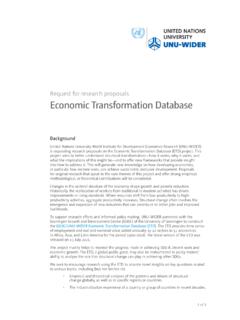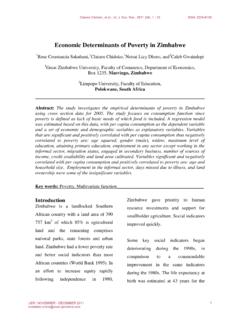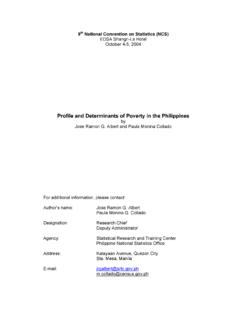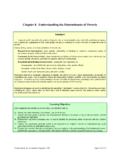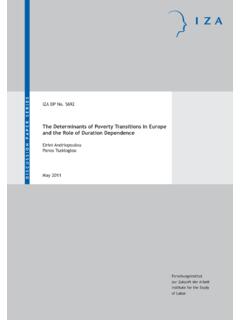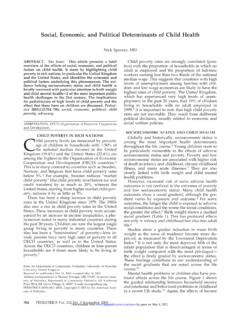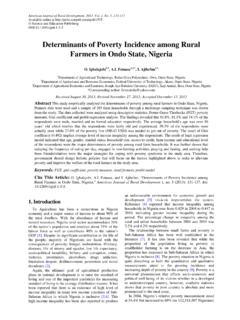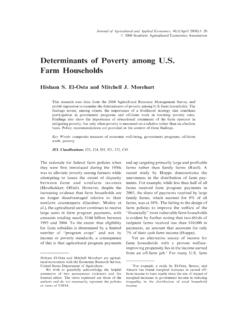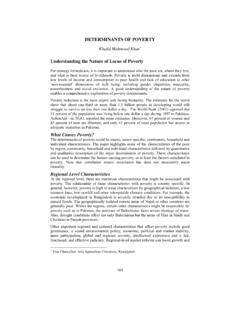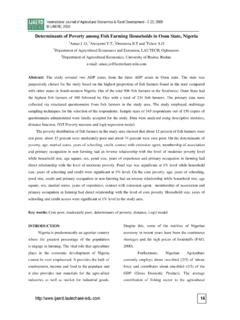Transcription of Discussion Paper No. 2002/37 Gender and Education as ...
1 Discussion Paper No. 2002/37 . Gender and Education as determinants of Household poverty in Nigeria Christiana Okojie*. March 2002. Abstract The Paper examines the linkages between Gender of household heads, Education and household poverty in Nigeria between 1980 and 1996. Data analyzed were obtained from four national consumer expenditure surveys conducted in Nigeria in 1980, 1985, 1992 and 1996 by the Federal Office of Statistics. Adjustments were made for price differentials over time and across regions of the country. However, only aggregated data for households were available. Per capita expenditure was used as the indicator of poverty , while the unit of analysis was the household. Two poverty lines were set: a moderate poverty line equal to two-thirds of mean per capita household expenditure, and a core poverty line equal to one-third of mean per capita expenditure. The P index proposed by Foster, Greer and Thorbecke was used to generate the headcount ratio as well as the depth and severity of poverty .
2 Trends in inequality were analyzed using Gini coefficients and the Theil's index. Multivariate analysis was used to examine the relationships between Gender , poverty and other household variables, including Education , for all households as well as for subgroups of male-headed and female-headed households respectively. / . Keywords: Gender , Education , poverty , Nigeria, households JEL classification: I32. Copyright author(s) 2002. * Department of Economics and Statistics, University of Benin This study is linked to the theme of Growth and poverty discussed at the WIDER Development Conference, 25-26 May 2001, Helsinki. UNU/WIDER gratefully acknowledges the financial support from the governments of Denmark, Finland and Norway to the 2000-2001 research programme The analysis showed that poverty increased substantially in Nigeria between 1980 and 1996. The poverty headcount increased from percent in 1980 to percent in 1985, it declined to percent in 1992, but increased to percent by 1996.
3 Furthermore, The Gini coefficient and Theil's Entropy Indices showed that the level of inequality is fairly high in Nigeria. Much of the inequality was within-group rather than between groups for all survey periods. Multivariate analysis for all households showed that female-headed households are more likely to be poor for all survey periods. Education decreased the likelihood of being poor while larger households were more likely to be poor. The two variables were also significant when separate regressions were run for male and female- headed households. These findings suggest that policy attention should be directed at increasing female Education and reducing fertility levels since poverty was higher in larger households. Acknowledgements The author acknowledges with gratitude the financial and training support of the African Economic Research Consortium, Nairobi, for the research project which provided the material for this Paper .
4 The author also gratefully acknowledges comments from an anonymous reviewer of this Paper . UNU World Institute for Development Economics Research (UNU/WIDER) was established by the United Nations University as its first research and training centre and started work in Helsinki, Finland in 1985. The purpose of the Institute is to undertake applied research and policy analysis on structural changes affecting the developing and transitional economies, to provide a forum for the advocacy of policies leading to robust, equitable and environmentally sustainable growth, and to promote capacity strengthening and training in the field of economic and social policy making. Its work is carried out by staff researchers and visiting scholars in Helsinki and through networks of collaborating scholars and institutions around the world. UNU World Institute for Development Economics Research (UNU/WIDER). Katajanokanlaituri 6 B, 00160 Helsinki, Finland Camera-ready typescript prepared by Lorraine Telfer-Taivainen at UNU/WIDER.
5 Printed at UNU/WIDER, Helsinki The views expressed in this publication are those of the author(s). Publication does not imply endorsement by the Institute or the United Nations University, nor by the programme/project sponsors, of any of the views expressed. ISSN 1609-5774. ISBN 92-9190-196-2 (printed publication). ISBN 92-9190-197-0 (internet publication). 1 Introduction The relationship between Gender and poverty has become an important topic in the literature on poverty . A large body of literature has focussed on female-headed households and the disadvantages they face (Buvinic and Gupta, 1997; Appleton, 1996). Gender is now regarded as an essential concept for the analysis and eradication of poverty . The causes and outcomes of poverty are seen as heavily engendered while traditional conceptualizations consistently failed to delineate poverty 's Gender dimensions, resulting in policies and programmes which failed to improve the lives of poor women and their families (Beneria and Bisnath, 1996).
6 It is now recognized that women are disproportionately represented among poor households and that poverty is being increasingly feminized. To eradicate poverty , the Gender dimension needs to be addressed in development planning. The term feminization of poverty ' appeared in the mid 1980s and was used to describe the growing proportion of women and of households headed by women in the ranks of the poor during the recession of the early 1980s, and in the context of cutbacks in welfare programmes (UN, 1995). Analysis of female poverty suggests that the main causes arise from the perpetual disadvantages which women face in terms of their position in the labour market, and their limited access to productive resources, Education and income for the satisfaction of their basic needs. Experience has shown that any approach to poverty alleviation that leaves the economic situation of women unchanged tends to fall short of its goal (UN, 1995).
7 Studies of poverty often take the household as the unit of analysis without differentiating levels of poverty of each household member. It is suggested that the conventional household survey approach does not allow direct measurement of income poverty among women. This is regarded as one reason why data on Education and health, which can be collected at the individual level, are valuable as they facilitate a Gender -disaggregated perspective on many dimensions of poverty (World Bank, 2000). In examining the relationship between Gender of household head and poverty , there are two aspects to be examined (Appleton, 1996; Sahn et al., 1990). The first question is, can Gender of household heads be used to predict poverty ? The second is, what are the likely determinants of poverty and how do such factors differ between male and female-headed households? That is, what are the particular features of female-headed households that make them vulnerable to poverty , and what measures are required to reduce their vulnerability to poverty ?
8 While evidence from some countries suggests that the incidence of poverty is higher in female-headed households, the contrary is the case in others. Analyses of poverty among male-headed and female-headed households across a large number of developing countries have found mixed evidence. For example, surveys of household consumption and expenditure in many countries of North and South America, Europe and the Commonwealth of Independent States (CIS) show the incidence of income poverty to be higher among female-headed households. But elsewhere, there is no difference between male-headed and female-headed households Zimbabwe, Viet Nam, Morocco, and Indonesia, for example. According to Lipton and Ravallion (1995), females are not generally over-represented in consumption-poor households; nor are female-headed households more likely to be poor as a rule (see for example, Haddad, 1991 for Ghana, and Louat et al., 1995). A review of 61 studies on headship and poverty found female-headed households to be 1.
9 Disproportionately represented among the poor in 38 cases (Buvinic and Gupta, 1997). In contrast to this, another study (Quisumbing, Haddad, and Pena, 2000) found robust and statistically significant differences in poverty between female and male-headed households in only two cases. Other recent studies find that evidence varies across countries, studies, and methodologies (World Bank, 2001). According to Kabeer (1992), little is known about the distribution of income/consumption in male-headed households below the poverty line. However, even if it were true that consumption- poverty incidence is on average no greater amongst women, they are severe victims of poverty in other respects, for example, access to Education . The precarious position of women in the global economy is in part related to their low educational levels, including high levels of illiteracy in many countries (Beneria and Bisnath, 1996). This Paper examines the linkages between Gender of household heads, Education and household poverty in Nigeria between 1980 and 1996.
10 Section two of this Paper reviews the literature on the interrelationships between Gender , Education and poverty . Section three describes the data sources and methods used in the Paper . Section four discusses trends in poverty and inequality in Nigeria while section five presents the model specification, estimation and testing procedures. Section six presents the results of the multivariate analysis. Section seven reviews past poverty alleviation programmes in Nigeria while section eight concludes the Paper . 2 Review of the literature Gender and Education In the last three decades, the United Nations has been at the forefront of efforts to promote the status of women. Several conferences and seminars within and between countries have focussed on Gender and Education . Comprehensive plans of action have emerged from some of them on what needs to be done to address Gender imbalance in Education . In all countries, Education is now recognized as a major vehicle for promoting and improving the status of women.




